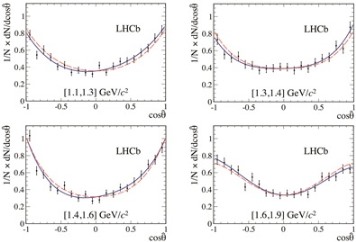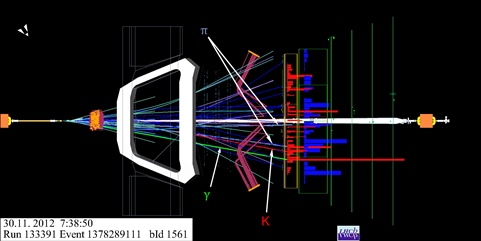The LHCb Collaboration has submitted today for publication a paper reporting the first observation of photon polarisation in b→sγ transition. The full 3 fb-1 Run 1 data sample was used to obtain this result. The Collaboration has presented already the first evidence for the photon polarization in this process at the summer 2013 conferences using about 2/3 of the whole data sample, see the news of 19 July 2013 for an introduction.
Photon polarization is the quantum mechanical description of the classical polarized sinusoidal plane electromagnetic wave. Individual photon can have either right or left circular polarization or a superposition of both, read more here.
The beauty particles decay mainly into charm particles, less frequently into strange particles. About once in every 3000 decays into strange particles a photon is emitted. At the underlying quark level a beauty b quark turns into a strange quark s by emitting a photon γ. This famous b→sγ transition is considered as a very interesting process in which signs of new physics could show up. The first evidence for this process was obtained by the CLEO Collaboration in 1993 and since then it was intensively studied in many experiments. This decays occurs only rarely since it requires a quantum fluctuation where a pair of heavy particles (a top quark and a W boson) appear and then rapidly vanish. The interaction between these particles is such that the emitted photon is expected to be almost 100% (left-handed) polarized. However, since the “virtual” top and W particles are not seen in the detector, they could equally well be replaced by other even heavier particles that are predicted in various theories that go beyond the Standard Model. Such theories have been proposed to address important unresolved questions in particle physics, such as the origin of the imbalance between matter and antimatter seen in the Universe. These models generally predict different values for the photon polarisation, and therefore it is seen as one of the most important measurements that can be made with the latest generation of experiments.
click the images for higher resolution
Researchers from the LHCb experiment have now succeeded to observe a non-vanishing value of the polarisation for the first time with a significance of 5.2σ. The analysis is based on nearly 14000 B+→K+π– π+ γ decays, for which the distribution of the γ angle with respect to the normal to the plane defined by the kaon and two pion system is studied in four intervals of the K+π– π+ mass which are shown in the left image. The two curves are fits to the data points, allowing photon polarisation (solid blue curve) or setting it to zero (dashed red curve). The right image shows a typical B+→K+π– π+ γ event.
This investigation is conceptually similar to the historical Wu experiment that discovered parity violation by measuring the asymmetry of the direction of a particle emitted in a weak decay.
Read more in the LHCb publication here, in the CERN Courier article and in the CERN Bulletin article in English and French.


